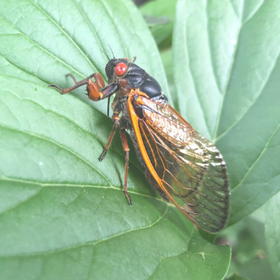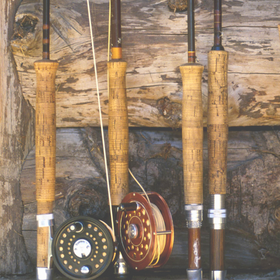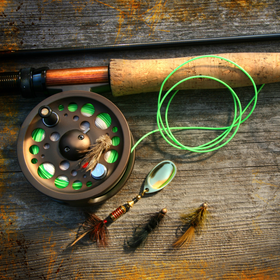 - Mayfly nymph (photo: www.troutnut.com)
- Mayfly nymph (photo: www.troutnut.com)
The wonderful insect that inspires all trout fly fisherman
Their names roll off the fly fisherman’s tongue like the names of lost
loves. Making the angler drool almost as much as the fish (if fish could
drool).
Hendricksons,
Green Drakes,
Blue Wing Olive,
Trico. If you are not in a state of Zen yet, remembering past fly fishing
experiences, then you probably are not yet an avid trout fly
fisherman.
For the novice, these are the common names given to various species of the
hallowed mayfly. The mayfly is to trout fly fishing what the microchip is to
the personal computer. Fly fishing never would have gotten off the ground if
trout didn’t leap up and ingest the adult mayfly, in a perfect display of
sleek efficient survival. This microcosm of the food chain has sparked fly
fisherman’s imagination for generations, and has led to the explosion of the
fly fishing experience that we see today.
But what about this insect called the
mayfly. Let’s take a closer look at the entire class of insect. The
mayfly
is so worthy of imitation for fly fisher's because they are varied, they are
prolific, and they live where ever trout live with few exceptions. They
require the same living conditions as trout, relatively clean and cool
water. They can vary in size to the tiny
Trico
down to size 24, all the way up to the giant
Hexagenia that can go up to size 4.
Some can hatch virtually year around while others have a relatively
specific and short hatch season. But despite all these variances there are
some things we can learn about the species as a whole. All mayflies begin
their life cycle in the water, as nymphs. Now with the emphasis on keeping
this simple, let me just break it down a little more. Nymphs can be
classified in four distinct categories. They are: clingers, swimmers,
burrowers, and crawlers.
 - March Brown nymph. March browns are clingers. (photo: www.troutnut.com)
- March Brown nymph. March browns are clingers. (photo: www.troutnut.com)
Clingers are built broad and flat and like faster moving water.
March Browns
and Light Cahills fall into this category. Their hatches are a little
more sporadic, but they can still offer excellent dry fly action. Their
emergence is relatively quick due to the nature of water they ware
found.
 - Isonychia, commonly called a
Mahogany. The nymph is a swimmer. (photo: www.troutnut.com)
- Isonychia, commonly called a
Mahogany. The nymph is a swimmer. (photo: www.troutnut.com)
Swimmers like the
Isonychias
like pools, and slower runs and riffles. They are excellent swimmers, and
strikes for them tend to be vicious. They can hatch heavily or
sporadically.
 -
Hendrickson nymph, a crawler (photo: www.troutnut.com)
-
Hendrickson nymph, a crawler (photo: www.troutnut.com)
Crawlers also prefer softer runs and riffles. These species such as the
Hendrickson
and
Sulphur
have the hardest time emerging from their shucks. Therefore, great fishing
can be found drifting nymphs or emerger patterns just below the surface
where fat fish love to slurp them up. Their hatches can be explosive and
really send fish into a frenzy.
 -
Hexagenia, a burrower and one of the larger mayflies. (photo: www.troutnut.com)
-
Hexagenia, a burrower and one of the larger mayflies. (photo: www.troutnut.com)
The burrowers like sandy or silt bottoms. They need the silt to burrow
and survive. Their hatches tend to be legendary and very popular. These
mayflies like the
Drakes
and
Hexes, are large and infamous. The hatches can be very thick, but are often
very short-lived. Anglers mark their calendars around them.
 - This mayfly died during it's emergence. It could also be called a
cripple at this stage as it did not complete it's emergence. (photo: www.troutnut.com)
- This mayfly died during it's emergence. It could also be called a
cripple at this stage as it did not complete it's emergence. (photo: www.troutnut.com)
After the nymph stage comes the
emerger
stage, which we covered somewhat above. The
emerger
stage is relatively new are of concentration for the fly angler. But it
has exploded in popularity, as this stage is the most vulnerable for the
mayfly. Not yet an adult and no longer a nymph, they are very clumsy in
the water and are free floating as they rise to the surface. Whole groups
of patterns have been designed just for this window of a mayflies
life.
For the novice fly fisher I hope this has given you a foundation for the
appreciation you will sure grow to have of this class of insects. And for
the ordained, now would be a good time to have your blood pressure
checked. I will discuss the adult mayfly in a future article.




